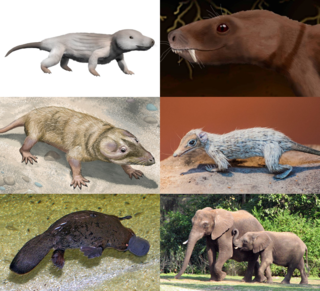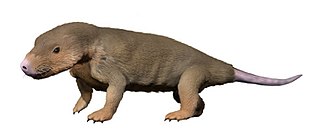
Therapsida is a clade comprising a major group of eupelycosaurian synapsids that includes mammals and their ancestors and close relatives. Many of the traits today seen as unique to mammals had their origin within early therapsids, including limbs that were oriented more underneath the body, resulting in a more "standing" quadrupedal posture, as opposed to the lower sprawling posture of many reptiles and amphibians.

Cynodontia is a clade of eutheriodont therapsids that first appeared in the Late Permian, and extensively diversified after the Permian–Triassic extinction event. Mammals are cynodonts, as are their extinct ancestors and close relatives (Mammaliaformes), having evolved from advanced probainognathian cynodonts during the Late Triassic.

Probainognathus meaning “progressive jaw” is an extinct genus of cynodonts that lived around 235 to 221.5 million years ago, during the Late Triassic in what is now Argentina. Together with the genus Bonacynodon from Brazil, Probainognathus forms the family Probainognathidae. Probainognathus was a relatively small, carnivorous or insectivorous cynodont. Like all cynodonts, it was a relative of mammals, and it possessed several mammal-like features. Like some other cynodonts, Probainognathus had a double jaw joint, which not only included the quadrate and articular bones like in more basal synapsids, but also the squamosal and surangular bones. A joint between the dentary and squamosal bones, as seen in modern mammals, was however absent in Probainognathus.

Therocephalia is an extinct clade of eutheriodont therapsids from the Permian and Triassic periods. The therocephalians ("beast-heads") are named after their large skulls, which, along with the structure of their teeth, suggest that they were carnivores. Like other non-mammalian synapsids, therocephalians were once described as "mammal-like reptiles". Therocephalia is the group most closely related to the cynodonts, which gave rise to the mammals, and this relationship takes evidence in a variety of skeletal features. Indeed, it had been proposed that cynodonts may have evolved from therocephalians and so that therocephalians as recognised are paraphyletic in relation to cynodonts.

The theriodonts are a major group of therapsids which appeared during the Middle Permian and which includes the gorgonopsians and the eutheriodonts, itself including the therocephalians and the cynodonts.

Moschorhinus is an extinct genus of therocephalian synapsid in the family Akidnognathidae with only one species: M. kitchingi, which has been found in the Late Permian to Early Triassic of the South African Karoo Supergroup. It was a large carnivorous therapsid, reaching 1.1–1.5 metres (3.6–4.9 ft) in total body length with the largest skull comparable to that of a lion in size, and had a broad, blunt snout which bore long, straight canines.

Theriognathus is an extinct genus of therocephalian therapsid belonging to the family Whaitsiidae, known from fossils from South Africa, Zambia, and Tanzania. Theriognathus has been dated as existing during the Late Permian. Although Theriognathus means mammal jaw, the lower jaw is actually made up of several bones as seen in modern reptiles, in contrast to mammals. Theriognathus displayed many different reptilian and mammalian characteristics. For example, Theriognathus had canine teeth like mammals, and a secondary palate, multiple bones in the mandible, and a typical reptilian jaw joint, all characteristics of reptiles. It is speculated that Theriognathus was either carnivorous or omnivorous based on its teeth, and was suited to hunting small prey in undergrowth. This synapsid adopted a sleek profile of a mammalian predator, with a narrow snout and around 1 meter long. Theriognathus is represented by 56 specimens in the fossil record.

Scylacops is an extinct genus of Gorgonopsia. It was first named by Broom in 1913, and contains two species, S. bigendens, and S. capensis. Its fossils have been found in South Africa and Zambia. It is believed to be closely related to the Gorgonopsian Sauroctonus progressus. Scylacops was a moderately sized Gorgonopsid.
Cynosaurus is an extinct genus of cynodonts. Remains have been found from the Dicynodon Assemblage Zone in South Africa. Cynosaurus was first described by Richard Owen in 1876 as Cynosuchus suppostus. Cynosaurus has been found in the late Permian period. Cyno- is derived from the Greek word kyon for dog and –sauros in Greek meaning lizard.

Glanosuchus is a genus of scylacosaurid therocephalian from the Late Permian of South Africa. The type species G. macrops was named by Robert Broom in 1904. Glanosuchus had a middle ear structure that was intermediate between that of early therapsids and mammals. Ridges in the nasal cavity of Glanosuchus suggest it had an at least partially endothermic metabolism similar to modern mammals.

Microgomphodon is an extinct genus of therocephalian therapsid from the Middle Triassic of South Africa and Namibia. Currently only one species of Microgomphodon, M. oligocynus, is recognized. With fossils present in the Cynognathus Assemblage Zone (CAZ) of the Burgersdorp Formation in South Africa and Omingonde Formation of Namibia and ranging in age from late Olenekian to Anisian, it is one of the most geographically and temporally widespread therocephalian species. Moreover, its occurrence in the upper Omigonde Formation of Namibia makes Microgomphodon the latest-surviving therocephalian. Microgomphodon is a member of the family Bauriidae and a close relative of Bauria, another South African bauriid from the CAZ. Like other bauriids, it possesses several mammal-like features such as a secondary palate and broad, molar-like postcanine teeth, all of which evolved independently from mammals.
Platycraniellus is an extinct genus of carnivorous cynodonts from the Early Triassic. It is known from the Lystrosaurus Assemblage Zone of the Normandien Formation in South Africa. P. elegans is the only species in this genus based on the holotype specimen from the Ditsong National Museum of Natural History in Pretoria, South Africa. Due to limited fossil records for study, Platycraniellus has only been briefly described a handful of times.

Scymnosaurus is a dubious genus of therocephalian therapsids based upon various fossils of large early therocephalians. The genus was described by Robert Broom in 1903 with S. ferox, followed by S. watsoni in 1915 and a third, S. major, by Lieuwe Dirk Boonstra in 1954. Each of these species are considered nomen dubia today and based upon specimens belonging to two separate families of therocephalians. S. ferox and S. major represent specimens of Lycosuchidae incertae sedis, while S. watsoni is Scylacosauridae incertae sedis. Broom named a fourth species in 1907 from KwaZulu-Natal, S. warreni, though he later referred it to Moschorhinus as a valid species in 1932 but now is recognised as being synonymous with M. kitchingi.

Vancleavea is a genus of extinct, armoured, non-archosaurian archosauriforms from the Late Triassic of western North America. The type and only known species is V. campi, named by Robert Long & Phillip A Murry in 1995. At that time, the genus was only known from fragmentary bones including osteoderms and vertebrae. However, since then many more fossils have been found, including a pair of nearly complete skeletons discovered in 2002. These finds have shown that members of the genus were bizarre semiaquatic reptiles. Vancleavea individuals had short snouts with large, fang-like teeth, and long bodies with small limbs. They were completely covered with bony plates known as osteoderms, which came in several different varieties distributed around the body. Phylogenetic analyses by professional paleontologists have shown that Vancleavea was an archosauriform, part of the lineage of reptiles that would lead to archosaurs such as dinosaurs and crocodilians. Vancleavea lacks certain traits which are present in most other archosauriforms, most notably the antorbital, mandibular and supratemporal fenestrae, which are weight-saving holes in the skulls of other taxa. However, other features clearly support its archosauriform identity, including a lack of intercentra, the presence of osteoderms, an ossified laterosphenoid, and several adaptations of the femur and ankle bones. In 2016, a new genus of archosauriform, Litorosuchus, was described. This genus resembled both Vancleavea and more typical archosauriforms in different respects, allowing Litorosuchus to act as a transitional fossil linking Vancleavea to less aberrant archosauriforms.

Bauriidae is an extinct family of therocephalian therapsids. Bauriids were the latest-surviving group of therocephalians after the Permian–Triassic extinction event, going extinct in the Middle Triassic. They are among the most advanced eutherocephalians and possess several mammal-like features such as a secondary palate and wide postcanine teeth at the back of the jaws. Unlike other therocephalians, bauriids were herbivorous. They were also smaller than earlier members of the group. Two subfamilies are classified within Bauriidae: Nothogomphodontinae and Bauriinae.
Homodontosaurus is an extinct genus of therocephalian therapsids from the Late Permian of South Africa. The type species Homodontosaurus kitchingi was named by South African paleontologist Robert Broom in 1949. Broom based his description on a small skull found in the Cistecephalus Assemblage Zone near Graaff-Reinet. The skull is very small, at about 55 millimetres (2.2 in) long and 20 millimetres (0.79 in) wide. Homodontosaurus has large eye sockets and an elongated snout. The lower jaw is long, thin, and curved. Numerous small teeth line the upper jaw and are long, pointed, and round in cross-section.
Ictidodraco is an extinct genus of therocephalian therapsids from the Late Permian of South Africa. The type species Ictidodraco longiceps was named by South African paleontologists Robert Broom and John T. Robinson in 1948 from the Cistecephalus Assemblage Zone. Ictidodraco was once classified as a scaloposaurian in the family Silpholestidae. Scaloposauria and Silpholestidae are no longer regarded as valid groups, and Ictidodraco is now classified as a basal member of the clade Baurioidea.

Hazhenia is an extinct genus of therocephalian therapsids from the Early Triassic of China, of which Hazhenia concava is the only species. Hazhenia was named in 1981 from the Heshanggou Formation in the Ordos Desert of Inner Mongolia. It lived during the Olenekian Age of the Early Triassic, about 247 million years ago. Hazhenia belongs to a group of therocephalians called Baurioidea and possesses many mammal-like features such as cusped teeth and a secondary palate, both of which evolved independently in baurioids. Within Baurioidea it is most closely related to the genus Ordosiodon, which is also known from Inner Mongolia but comes from the slightly younger Ermaying Formation. Both genera were once placed in the family Ordosiidae, but as the name is preoccupied by a family of Cambrian trilobites, it is no longer valid.
Eohyosaurus is an extinct genus of basal rhynchosaur known from the early Middle Triassic Burgersdorp Formation of Free State, South Africa. It contains a single species, Eohyosaurus wolvaardti.

Abdalodon is an extinct genus of late Permian cynodonts, known by its only species A. diastematicus.Abdalodon together with the genus Charassognathus, form the clade Charassognathidae. This clade represents the earliest known cynodonts, and is the first known radiation of Permian cynodonts.






















